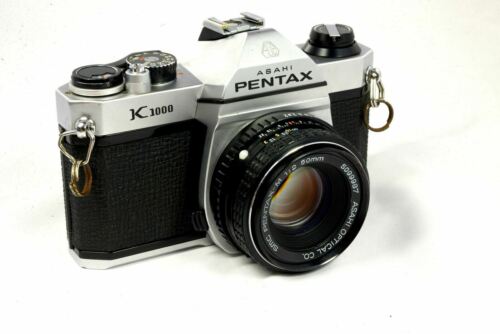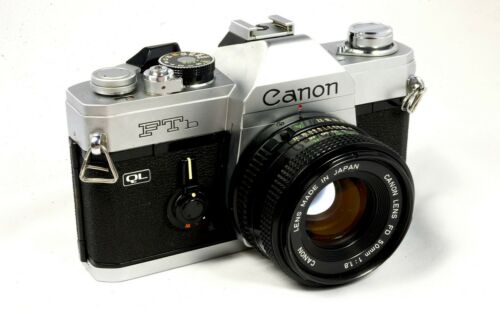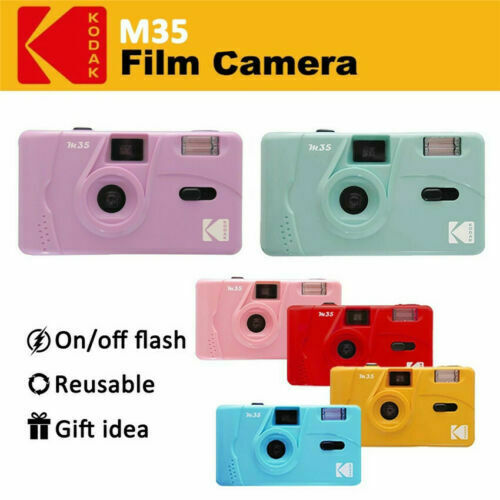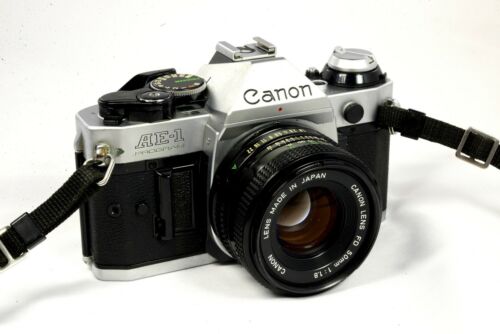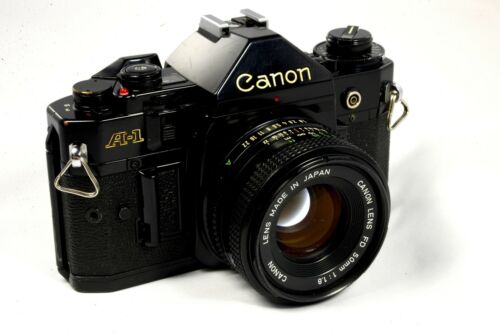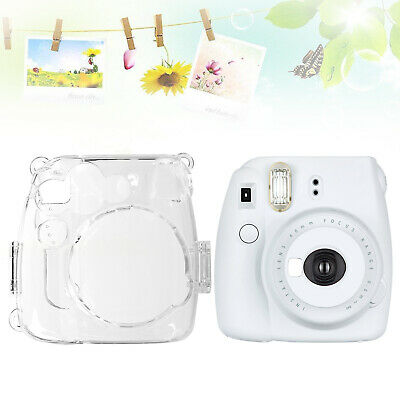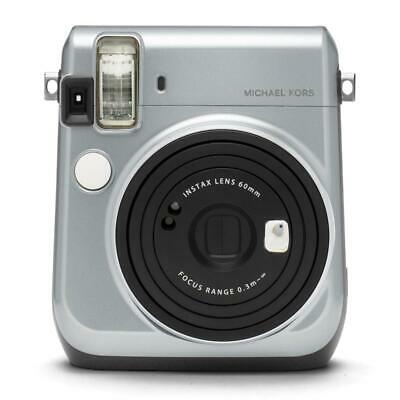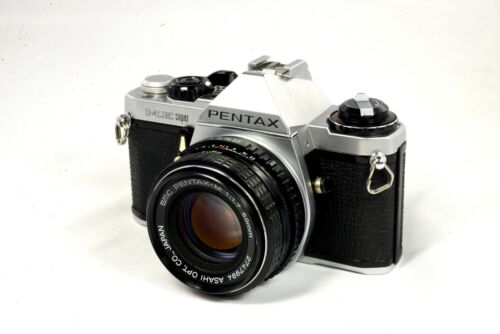-40%
1979 Nearly New Nikon EM SLR Film Camera 35mm With 50mm f/1.8 Nikkor Lens
$ 0.52
- Description
- Size Guide
Description
Nikon EM SLR Film CameraVintage Original Item Made in Japan
Launched During 1979-1982
Mint Condition・90% Nearly New
Consumer-grade 35mm classically Beautiful And Functional SLR
Nikon EM:
The story of the EM really starts with the story of the 1970s consumer SLR boom. The introduction of the Canon AE-1 sparked a wave of consumer-grade cameras which featured electronic auto-exposure aids which were left off of many professional-grade cameras of the day. The market responded well to these amateur-oriented cameras, which prompted several manufacturers to come up with their own iterations of the format.
The shift in design philosophy does result in the EM’s unique character. Nikon called in famed Italian designer Giorgetto Giugiaro to design the EM, which resulted in a radically different look. Giugiaro gave the EM its simple, graceful lines, a small form factor, and a black leatherette covering not found on any other Nikon camera. Whereas the pro-grade F-series and advanced amateur FM-chassis cameras were examples of uncompromising industrial design, the EM took the more stylish route. It worked – the EM stood apart from the rest of the Nikon lineup, and inadvertently set an example for all Nikons to follow. Giugiaro himself even took what he learned with the EM and designed the Nikon F3, one of the most classically beautiful and functional SLRs ever made.
Content Item:
Nikon EM camera body, With Nikkor 50mm f/1.8 Lens attached( and camera strap attached )
Specification
Format:
35mm (24mm x 36mm frame size)
Type:
35mm single-lens reflex (SLR), aperture-priority automatic
Lens mount
:
Nikon bayonet type
Nikon Series E 50mm f/1.8 as standard; other Series E lenses; most Nikkor lenses including AI-types. Warning: Non-AI lenses cannot be used.
Viewfinder
:
Fixed eye-level pentaprism full-aperture viewing type with built-in TTL exposure meter; shutter speed scale and exposure needle visible inside; ready-light lights up when Speedlight SB-E, SB-15, or SB-16B is in use; center of scales' bracket indicates 1/90 sec.; finder coverage approx. 92 % of picture field; 0.86X magnification with 50mm lens set at infinity.
Film advance:
Electronically controlled, vertical-travel, metal focal-plane shutter; stepless speeds from 1 sec. to 1/1000 sec. when shutter operation mode selector is set to AUTO; 1/90 sec. mechanical shutter speed when set to M90; B setting also provided for long exposures. Film winding lever provided; completed stroke of 144°; choice of one continuous stroke or series of shorter strokes
Focusing screen
:
Fixed-type Nikon "K" screen; comprises matte fresnel field with central split-image rangefinder spot surrounded by microprism ring and 12mm-dia. reference circle which denotes the area of center-weighted metering
Exposure measurement:
TTL center-weighted exposure metering at full aperture; meter incorporates one silicon photodiode (SPD).
Reflex mirror:
Instant-return, non-lockable type
Self-timer:
Lever provided can be set for approx. 10-sec. exposure delay; setting cancelable before shutter release button is pressed.
Metering range:
EV 2 to EV 18 (i.e., f/2 at 1 sec. to f/16 at 1/1000 sec. at ASA/ISO 100 and with 50mm f/1.8 lens)
Exposure signal:
"Beep-beep" warning sound activated when the shutter release button is pressed to finger guard position if matching shutter speed for lens aperture set is below approx. 1/30 sec. or above 1/1000 sec.
Exposure compensation
:
+ 2 EV when exposure compensation button is kept depressed as the shutter release button is pressed
Meter power source
:
One 3V lithium battery or two 1.55V silver-oxide batteries *
Meter ON/OFF switch
:
Meter switched on when the shutter release button is pressed; stays switched on for several seconds after the finger is lifted off button.
Battery power checker
:
LED lamp lights up to indicate sufficient power availability when the power check button is pressed
Film speed range
:
ASA/ISO 25-1600
Frame counter
:
Shows the number of frames exposed, automatically resets to "S" when camera back is opened; automatic operation starts from frame 1
Film rewind
:
Manual; film rewind crank rotated after film rewind button is depressed
Flash synchronization
:
Built-in ISO-type hot-shoe, automatic flash sync at 1/90 sec. with SB-E, SB-15, or SB-16B or any dedicated Nikon flash units; activates camera's ready-light when flash is ready; with SB-E, ready-light "blinks" to signal incorrect ASA/ISO aperture combination; M90 shutter mode-selector setting used with other electronic flash units, providing flash sync at 1/90 sec.
Motor drive coupling
:
Electrical contact and coupler built-in for operation with Motor Drive MD-E
Dimensions
:
135mm(W) x 86mm(H) x 54mm(D)
Reviews and Defects
Beneath the shell, the main structure of Nikon EM is a sturdy metal structure. Made of copper silumin aluminum alloy, this is the very same metal used for the body of the Nikon F3 - Nikon's top-of-the-line professional camera during the eighties. Unlike other die-cast materials, this alloy is less susceptible to blowholes during manufacture; therefore, the casting is stronger and more durable. In fact, the EM's die-cast body has a tensile strength of approx. 33.5kg/mm2 - remarkably high for cameras in this class. Thus, you can be sure that the Nikon EM is as rugged and reliable a camera as you want it to be.
There are a host of other features provided in the EM. As this is essentially a battery-dependent electronic camera, it has a few features to comfort the users. First is a battery check button and a red LED allows you to check the condition of the 3V lithium battery which powering the EM's metering circuits. It's easy to change the battery because it is housed in a readily accessible battery clip at the bottom of the camera.
(Instead of the lithium battery, two 1.55V silver-oxide cells can also be used)
.
To provide a user with a greater degree of control even if the EM is only providing aperture-priority AE, there are two ways: First is a built-in function where the exposure compensation button
(In front of the camera body, press to activate - confirmation by seeing the viewfinder match needle will automatically set two stops in shutter speed compensation)
.
Taking pictures with the EM is really easy. In technical terms, it uses an aperture-priority automatic exposure control system. In operation, just set a shooting aperture on the lens. Then, focus and shoot. The EM will automatically select the right shutter speed to match the user-selected aperture value for proper exposure. If the shutter speed goes outside of the "safe" range of approx. 1/30 to 1/1000 sec., there is even an electronic "beep-beep" that quietly warns you to readjust the aperture before taking the picture.
Those who think that the EM is still way too simplistic are in good company – Nikon thought so too. This can be deduced from Nikon’s treatment of the EM’s Nikon F-mount. The F-mount gave EM users access to the famed professional Nikkor lenses
(An original Nikkor 50mm f/1.8 Lens is attached to this camera )
, a huge plus for anybody looking to try out Nikon’s vast catalog of lenses. Nikon, however, did not want to associate the EM with their professional-grade offerings, and so developed the “Series E” line, a lower-grade line of lenses designed specifically for the lower-grade EM.
Disadvantages and defects
What really separates the EM from the rest of the Nikon lineup is its method of operation. Aside from the included mechanical override/flash sync speed of 1/90th of a second, the sole method of exposure is aperture-priority autoexposure. That's it. There's nothing else. No manual mode, no program mode – just aperture-priority.
Prior to the EM, Nikon built its name upon consummate quality and professionalism by any means necessary. The no-nonsense, all-metal, pro-spec Nikon F and F2 are prime examples of this function-first philosophy, as well as the advanced-amateur FE and FM series of cameras. The EM, however, is small, light, and features a lot of plastic. Granted, it still possesses a very sturdy aluminum chassis, but outwardly it just doesn't inspire that same sense of awe that comes from its cousins.
It is for this reason that the Nikon faithful shunned the EM, even though it sold pretty well. Nikon tried to save face with the even better and slightly rebranded FG but eventually scrapped their compact consumer SLR line entirely towards the end of the 1980s. The EM's reputation from this era has haunted the camera ever since, and it has never fully recovered.
If you hear a beeper sound, don't panic.
It is just a friendly warning device built into the EM to warn a user of possible camera shake due to prevailing light level demands a slower shutter speed settings OR a reminder where you can check if the aperture value set can be lower to raise the shutter speed to 'acceptable' level without the need of tripod support. Thus, whenever the shutter speed is not within the range of approx. 1/30 to 1/1000 sec., theM will emit a high-pitched electronic "beep-beep" sound when you depress the shutter button halfway to warn of such possibilities. Of cause, provided you know how to react to such a situation, you can still ignore and depress the shutter release fully to take an exposure.
The camera is in fully functional condition and extremely good cosmetic condition. There is no damage from use or years on the camera body. All other aspects are in good condition and all functions are working properly as expected. It seems the previous owner even didn't use it at all.
It seems that the machine is in very good condition, except for very little dust. The
overall appearance looks just like a new camera. As shown in the pictures. But
there are several dust dots in the finder
. Although it does not affect the sight-taking at all, it is better to perform maintenance if mind it.
Manual
1979 Nearly New Nikon EM SLR Film Camera 35mm With 50mm f/1.8 Nikkor Lens
Nikon EM SLR Film Camera
Vintage Original Item Made in Japan
Launched During 1979-1982
Mint Condition・90% Nearly New
Consumer-grade 35mm classically Beautiful And Functional SLR
Nikon EM:
The story of the EM really starts with the story of the 1970s consumer SLR boom. The introduction of the Canon AE-1 sparked a wave of consumer-grade cameras which featured electronic auto-exposure aids which were left off of many professional-grade cameras of the day. The market responded well to these amateur-oriented cameras, which prompted several manufacturers to come up with their own iterations of the format.
The shift in design philosophy does result in the EM’s unique character. Nikon called in famed Italian designer Giorgetto Giugiaro to design the EM, which resulted in a radically different look. Giugiaro gave the EM its simple, graceful lines, a small form factor, and a black leatherette covering not found on any other Nikon camera. Whereas the pro-grade F-series and advanced amateur FM-chassis cameras were examples of uncompromising industrial design, the EM took the more stylish route. It worked – the EM stood apart from the rest of the Nikon lineup, and inadvertently set an example for all Nikons to follow. Giugiaro himself even took what he learned with the EM and designed the Nikon F3, one of the most classically beautiful and functional SLRs ever made.
Content Item:
Nikon EM camera body, With Nikkor 50mm f/1.8 Lens attached( and camera strap attached )
Specification
Format:
35mm (24mm x 36mm frame size)
Type:
35mm single-lens reflex (SLR), aperture-priority automatic
Lens mount
:
Nikon bayonet type
Nikon Series E 50mm f/1.8 as standard; other Series E lenses; most Nikkor lenses including AI-types. Warning: Non-AI lenses cannot be used.
Viewfinder
:
Fixed eye-level pentaprism full-aperture viewing type with built-in TTL exposure meter; shutter speed scale and exposure needle visible inside; ready-light lights up when Speedlight SB-E, SB-15, or SB-16B is in use; center of scales' bracket indicates 1/90 sec.; finder coverage approx. 92 % of picture field; 0.86X magnification with 50mm lens set at infinity.
Film advance:
Electronically controlled, vertical-travel, metal focal-plane shutter; stepless speeds from 1 sec. to 1/1000 sec. when shutter operation mode selector is set to AUTO; 1/90 sec. mechanical shutter speed when set to M90; B setting also provided for long exposures. Film winding lever provided; completed stroke of 144°; choice of one continuous stroke or series of shorter strokes
Focusing screen
:
Fixed-type Nikon "K" screen; comprises matte fresnel field with central split-image rangefinder spot surrounded by microprism ring and 12mm-dia. reference circle which denotes the area of center-weighted metering
Exposure measurement:
TTL center-weighted exposure metering at full aperture; meter incorporates one silicon photodiode (SPD).
Reflex mirror:
Instant-return, non-lockable type
Self-timer:
Lever provided can be set for approx. 10-sec. exposure delay; setting cancelable before shutter release button is pressed.
Metering range:
EV 2 to EV 18 (i.e., f/2 at 1 sec. to f/16 at 1/1000 sec. at ASA/ISO 100 and with 50mm f/1.8 lens)
Exposure signal:
"Beep-beep" warning sound activated when the shutter release button is pressed to finger guard position if matching shutter speed for lens aperture set is below approx. 1/30 sec. or above 1/1000 sec.
Exposure compensation
:
+ 2 EV when exposure compensation button is kept depressed as the shutter release button is pressed
Meter power source
:
One 3V lithium battery or two 1.55V silver-oxide batteries *
Meter ON/OFF switch
:
Meter switched on when the shutter release button is pressed; stays switched on for several seconds after the finger is lifted off button.
Battery power checker
:
LED lamp lights up to indicate sufficient power availability when the power check button is pressed
Film speed range
:
ASA/ISO 25-1600
Frame counter
:
Shows the number of frames exposed, automatically resets to "S" when camera back is opened; automatic operation starts from frame 1
Film rewind
:
Manual; film rewind crank rotated after film rewind button is depressed
Flash synchronization
:
Built-in ISO-type hot-shoe, automatic flash sync at 1/90 sec. with SB-E, SB-15, or SB-16B or any dedicated Nikon flash units; activates camera's ready-light when flash is ready; with SB-E, ready-light "blinks" to signal incorrect ASA/ISO aperture combination; M90 shutter mode-selector setting used with other electronic flash units, providing flash sync at 1/90 sec.
Motor drive coupling
:
Electrical contact and coupler built-in for operation with Motor Drive MD-E
Dimensions
:
135mm(W) x 86mm(H) x 54mm(D)
Reviews and Defects
Beneath the shell, the main structure of Nikon EM is a sturdy metal structure. Made of copper silumin aluminum alloy, this is the very same metal used for the body of the Nikon F3 - Nikon's top-of-the-line professional camera during the eighties. Unlike other die-cast materials, this alloy is less susceptible to blowholes during manufacture; therefore, the casting is stronger and more durable. In fact, the EM's die-cast body has a tensile strength of approx. 33.5kg/mm2 - remarkably high for cameras in this class. Thus, you can be sure that the Nikon EM is as rugged and reliable a camera as you want it to be.
There are a host of other features provided in the EM. As this is essentially a battery-dependent electronic camera, it has a few features to comfort the users. First is a battery check button and a red LED allows you to check the condition of the 3V lithium battery which powering the EM's metering circuits. It's easy to change the battery because it is housed in a readily accessible battery clip at the bottom of the camera.
(Instead of the lithium battery, two 1.55V silver-oxide cells can also be used)
.
To provide a user with a greater degree of control even if the EM is only providing aperture-priority AE, there are two ways: First is a built-in function where the exposure compensation button
(In front of the camera body, press to activate - confirmation by seeing the viewfinder match needle will automatically set two stops in shutter speed compensation)
.
Taking pictures with the EM is really easy. In technical terms, it uses an aperture-priority automatic exposure control system. In operation, just set a shooting aperture on the lens. Then, focus and shoot. The EM will automatically select the right shutter speed to match the user-selected aperture value for proper exposure. If the shutter speed goes outside of the "safe" range of approx. 1/30 to 1/1000 sec., there is even an electronic "beep-beep" that quietly warns you to readjust the aperture before taking the picture.
Those who think that the EM is still way too simplistic are in good company – Nikon thought so too. This can be deduced from Nikon’s treatment of the EM’s Nikon F-mount. The F-mount gave EM users access to the famed professional Nikkor lenses
(An original Nikkor 50mm f/1.8 Lens is attached to this camera )
, a huge plus for anybody looking to try out Nikon’s vast catalog of lenses. Nikon, however, did not want to associate the EM with their professional-grade offerings, and so developed the “Series E” line, a lower-grade line of lenses designed specifically for the lower-grade EM.
Disadvantages and defects
What really separates the EM from the rest of the Nikon lineup is its method of operation. Aside from the included mechanical override/flash sync speed of 1/90th of a second, the sole method of exposure is aperture-priority autoexposure. That's it. There's nothing else. No manual mode, no program mode – just aperture-priority.
Prior to the EM, Nikon built its name upon consummate quality and professionalism by any means necessary. The no-nonsense, all-metal, pro-spec Nikon F and F2 are prime examples of this function-first philosophy, as well as the advanced-amateur FE and FM series of cameras. The EM, however, is small, light, and features a lot of plastic. Granted, it still possesses a very sturdy aluminum chassis, but outwardly it just doesn't inspire that same sense of awe that comes from its cousins.
It is for this reason that the Nikon faithful shunned the EM, even though it sold pretty well. Nikon tried to save face with the even better and slightly rebranded FG but eventually scrapped their compact consumer SLR line entirely towards the end of the 1980s. The EM's reputation from this era has haunted the camera ever since, and it has never fully recovered.
If you hear a beeper sound, don't panic.
It is just a friendly warning device built into the EM to warn a user of possible camera shake due to prevailing light level demands a slower shutter speed settings OR a reminder where you can check if the aperture value set can be lower to raise the shutter speed to 'acceptable' level without the need of tripod support. Thus, whenever the shutter speed is not within the range of approx. 1/30 to 1/1000 sec., theM will emit a high-pitched electronic "beep-beep" sound when you depress the shutter button halfway to warn of such possibilities. Of cause, provided you know how to react to such a situation, you can still ignore and depress the shutter release fully to take an exposure.
The camera is in fully functional condition and extremely good cosmetic condition. There is no damage from use or years on the camera body. All other aspects are in good condition and all functions are working properly as expected. It seems the previous owner even didn't use it at all.
It seems that the machine is in very good condition, except for very little dust. The
overall appearance looks just like a new camera. As shown in the pictures. But
there are several dust dots in the finder
. Although it does not affect the sight-taking at all, it is better to perform maintenance if mind it.
Manual
Discover more deals!
About Us
Payment
Returns & Refunds
Item Condition
Shipping
About Us
About Us
Payment
Returns & Refunds
Item Condition
Shipping
About Us
ENGEIKA
For the seeds you just plant, let's us join a hand to water it. As a plant grows with day-to-day care, at Engeika, your satisfaction grows with our lifelong experiences and the fullest attention.
Founded in 1987, Engeika has been known as a leading direct-to-customer e-commerce retailer specializing in writing instruments, watches, bags & cases, and recently lighters. Our mission is to bring the most wonderful products with the best quality and design to our customers from all over the world.
Engeika means horticulturists in Japanese. A horticulturist is a person who uses scientific as well as artistic knowledge to give the best caring to every single plant in his/her garden. The development of plants is his/her joy. And, the name says it all. We, at Engeika, love and proud to take care of each of you, our dear customers, as your satisfaction is our happiness and motivation every day.
In each product in our store, we would like to bring to YOU not only the BEST QUALITY or the MOST AMAZING DESIGN but also the INSPIRING STORY lying under each of them.
About Writing Instruments
Our story all starts with the love for fountain pens as well as all writing instruments. We used to be amateur in this field but time after time, knowledge is gained and experiences evolve. We are now proud to bring you not only the best writing products but also the most useful advice so that you can have the most satisfactory writing afterward. If you have any questions about writing, please ask us anytime, you will quickly find your answer with our help.
I love to receive messages from you! If you have any questions or inquiries, please FEEL FREE to ask me! Please click
here
to contact me through EbayPlease feel free to write to me in any language you like. I will try my best to understand your words and write to you in English or Japanese.
About Us
Payment
Returns & Refunds
Item Condition
Shipping
Payment
About Us
Payment
Returns & Refunds
Item Condition
Shipping
Payment
We only accept PayPal as it is the easiest and safest way to complete a transaction.
Please pay any invoice within 5 business days so we can prepare for your shipment as soon as possible.
Please click
here
to contact us if you have any questions.
About Us
Payment
Returns & Refunds
Item Condition
Shipping
Returns & Refunds
About Us
Payment
Returns & Refunds
Item Condition
Shipping
Returns & Refunds
Once the item has arrived to you, please kindly check it carefully. The return is only accepted during the return period. After that, any problems with your products will be able to send back to us and covered by the warranty from the manufacturer.
Please do not hesitate to contact us, if you have any other questions.
Return Eligibility:
Items must be in new condition and have not been used at all means.
Return Instructions:
Before returning any item, please contact in advance. We would like to hear the reason why you want to refund the item as we always want you to be happy with your purchase.
Refund:
Right after your item is delivered to our address, we will let you know and refund to your account as soon as possible.
About Us
Payment
Returns & Refunds
Item Condition
Shipping
Item Condition
About Us
Payment
Returns & Refunds
Item Condition
Shipping
Item Condition
100% Brand New?
All of your items are 100% Brand New and have NEVER been used at all means. However, please know that your order might be opened for inspection at the port of entry in your country.
Authenticity:
Yes. Everything we sell is authentic. We inspect every item for authenticity and operation and guarantee authenticity. With our long history serving customers from all over the world, you can feel secure when making a purchase from us.
About Us
Payment
Returns & Refunds
Item Condition
Shipping
Shipping
About Us
Payment
Returns & Refunds
Item Condition
Shipping
Shipping
*
Due to shipping restrictions because of the current global crisis, we are not able to ship to the following places:
-Kerala, Uttar Pradesh, West Bengal (States of India)
-North Korea
-Russia
Shipping Address:
Please input your shipping address in the English alphabet as it is required by our shipping courrier.
An up-to-date phone number is required. Please make sure your info on eBay/PayPal includes a valid phone number.
Custom/Import duty:
All our products are shipped from Japan and will be declared at the actual value of your product. Please kindly note that you are responsible for all customs and import fees when the parcel reaches the destination country and we will not be responsible for any customs and import fees charged.
Since customs duty varies for every country, the customs and import fees might be different depending on the shipping address. Please check with your country's regulations to calculate the fees.
If your parcel is returned back to us because of failure to pay the customs duty charges, you can choose to have it reshipped (you have to pay for the shipping again) or cancel the order. For the latter case, please note you will be refunded for your order after deducting the shipping fees for the two-way shipment.
No Additional Fee:
In order to ship your order, we always pay 100% of the shipping fee to the transportation company.
In 99% of cases, your order will reach your house while you DO NOT need to pay any extra fee. However, in some cases, after the item reaches your country, your local post office may charge you a few bucks for the rest of the delivery. We would like to ask for your cooperation and understanding.








